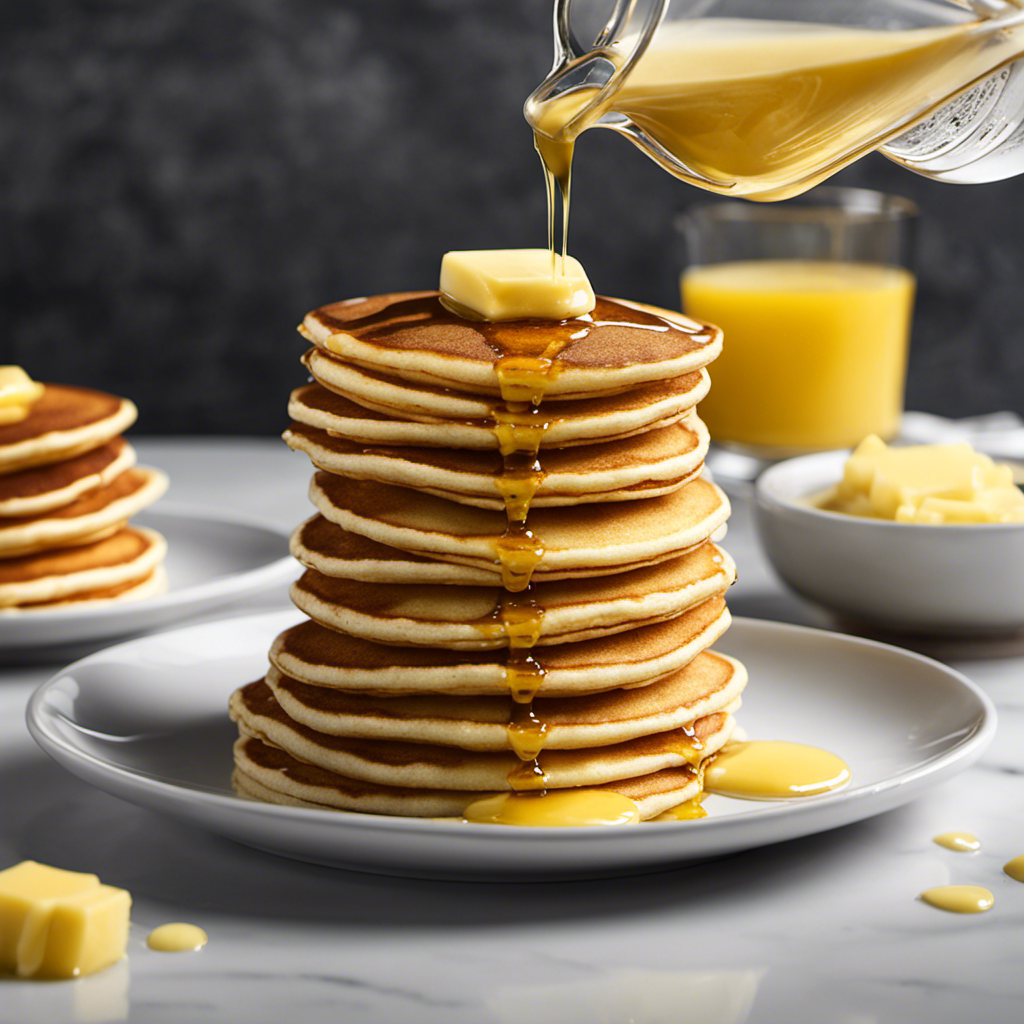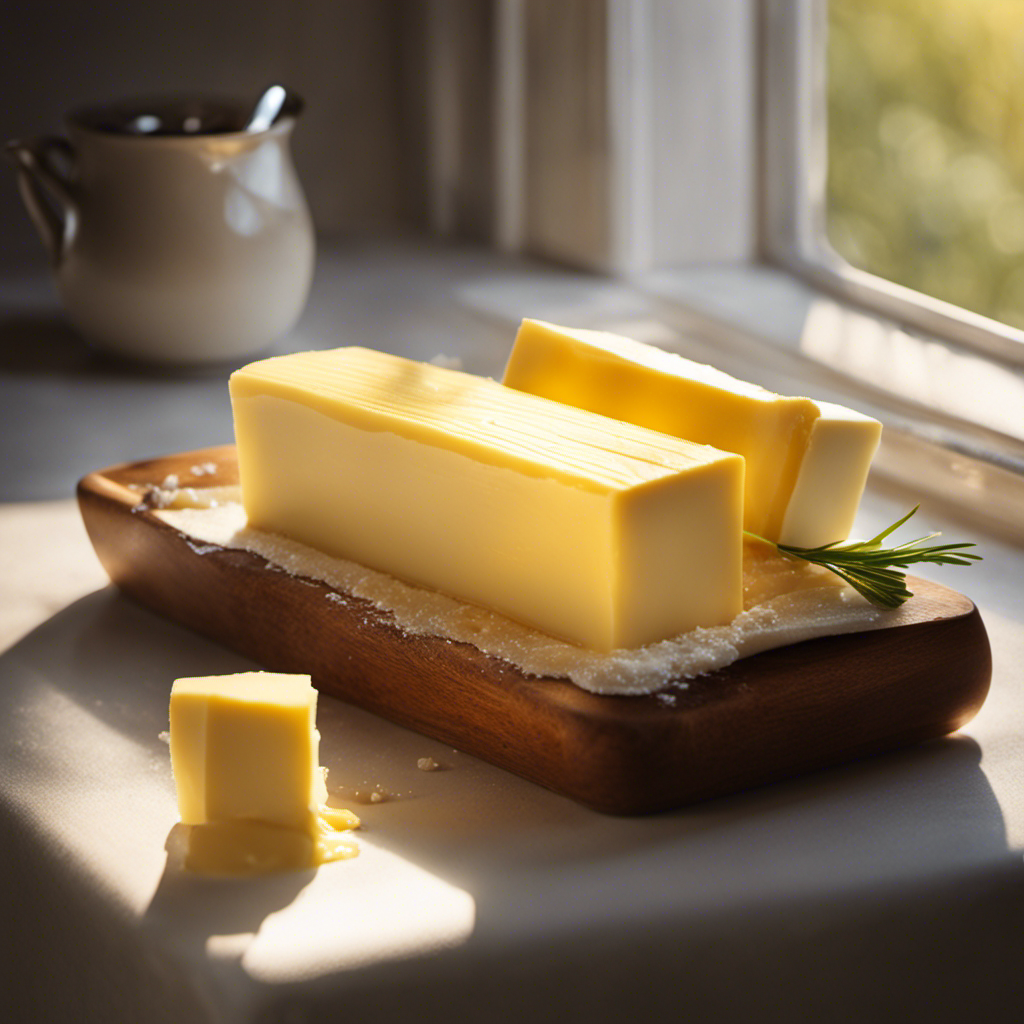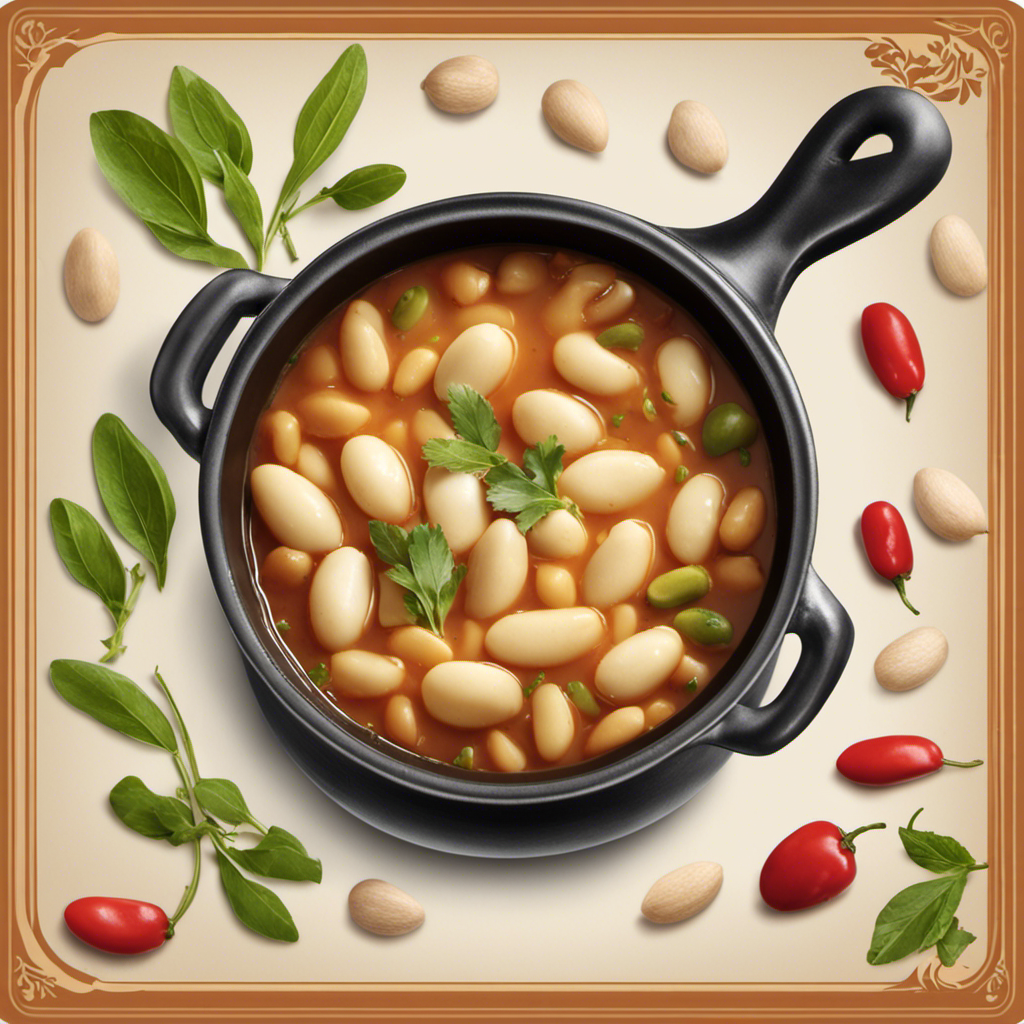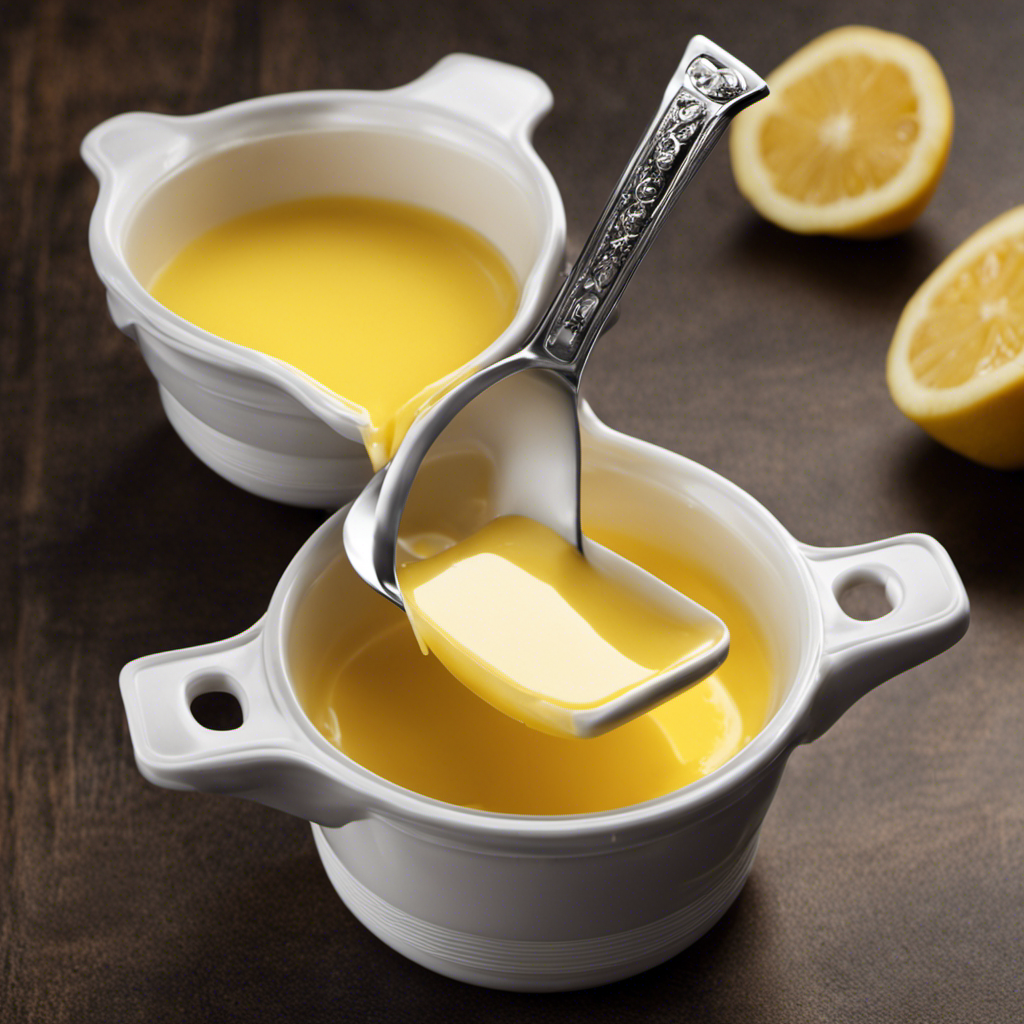I’ll always remember when I tried making chocolate chip cookies and mistakenly used an incorrect measure of butter. It turned into a complete mess! That’s the reason I’m here, to assist you in steering clear of the error I made.
In this article, I’ll explain how many tablespoons of butter are in 1/3 cup. Understanding this measurement is crucial for any recipe that calls for butter.
So, let’s dive in and master the art of butter measurements together.
Key Takeaways
- 1/3 cup of butter is approximately 5 and 1/3 tablespoons.
- To convert 1/3 cup to tablespoons, multiply 1/3 by 16, which gives you approximately 5.3 tablespoons of butter.
- Butter density can vary, with salted butter being denser than unsalted butter.
- Accurate measurement and substitution ensure consistent results in recipes.
Butter Measurements Explained
To measure 1/3 cup of butter, you’ll need about 5 and 1/3 tablespoons. When it comes to butter measurement equivalents, it is important to understand the calculations involved.
A cup of butter is equal to 16 tablespoons or 8 ounces. Therefore, 1/3 cup of butter would be approximately one-third of these measurements.
To calculate, we divide 16 tablespoons by 3, which gives us 5 and 1/3 tablespoons. This calculation is based on the fact that 1 cup is divided into 3 equal parts, and each part is equivalent to 1/3 cup.
Converting Cups to Tablespoons
You can easily convert 1/3 cup into tablespoons. To do this, you need to understand the conversion factor between cups and tablespoons. In the US, 1 cup is equal to 16 tablespoons. So, to convert 1/3 cup into tablespoons, you can multiply 1/3 by 16. This gives you approximately 5.3 tablespoons.
Now, if you want to convert tablespoons of butter to grams, you need to consider the weight conversion. One tablespoon of butter is equal to 14 grams. Therefore, if you have 5.3 tablespoons of butter, you can multiply this by 14 to get the weight in grams. This gives you approximately 74.2 grams of butter.
It is important to note that these conversions are approximate and can vary depending on the density of the butter.
Understanding the Butter-To-Cup Ratio
The ratio of butter to cups can vary depending on the density. It’s important to understand this ratio in order to accurately measure and substitute butter in recipes.
Here are some key points to help you understand butter measurements:
-
Butter density: Butter is not always the same density, which can affect the measurement. For example, salted butter is denser than unsalted butter.
-
Cup to tablespoon conversion: 1 cup of butter is equal to 16 tablespoons. This conversion can be used to determine how many tablespoons are in a fraction of a cup.
-
Butter substitution: If you need to substitute butter with a different ingredient, such as oil or margarine, it’s important to understand the ratio. For example, if a recipe calls for 1 cup of butter, you can substitute it with ¾ cup of oil.
Understanding the butter-to-cup ratio and knowing how to measure and substitute butter will help you achieve consistent and delicious results in your recipes.
The Scoop on 1/3 Cup of Butter
When it comes to baking, understanding butter measurements is essential. Knowing how to convert cups to tablespoons and vice versa can make a significant difference in the outcome of your recipes.
In this discussion, I will explain the butter measurements and provide you with handy kitchen conversion tips to ensure precision and accuracy in your culinary endeavors.
Butter Measurements Explained
To measure butter, simply convert 1/3 cup to tablespoons. 1/3 cup is equal to approximately 5 and 1/3 tablespoons of butter.
Here are some tips for measuring butter accurately:
- Use a liquid measuring cup with clear markings to measure the butter.
- Soften the butter to room temperature before measuring, as it will be easier to work with.
- Cut the butter into tablespoon-sized pieces to ensure an accurate measurement.
By following these tips, you can ensure that your recipes turn out just right.
Now that you know how to measure butter accurately, let’s move on to converting cups to tablespoons and explore more about butter measurements.
Converting Cups to Tablespoons
Converting cups to tablespoons is a useful skill in the kitchen. When it comes to butter measurements, understanding how to convert tablespoons to cups can help ensure accurate proportions in recipes.
To convert tablespoons to cups, remember that there are 16 tablespoons in one cup. So, if a recipe calls for 1/3 cup of butter, you can easily convert it to tablespoons by multiplying 1/3 by 16. This gives you approximately 5.33 tablespoons of butter.
However, it’s important to note that measuring butter in tablespoons can sometimes be challenging due to its solid state. To ensure accuracy, it’s recommended to use a kitchen scale or a butter dish with measurement markings.
Handy Kitchen Conversion Tips
If you’re looking to save time in the kitchen, knowing some handy kitchen conversion tips can be really helpful. When it comes to precision in measuring, accuracy is key.
Here are some tips for accurate measurements:
-
Use a kitchen scale: Weighing ingredients can ensure precise measurements, especially for ingredients like flour and sugar.
-
Use measuring spoons and cups: Investing in a set of measuring spoons and cups can help you achieve accurate measurements every time.
-
Level off dry ingredients: When measuring flour or sugar, use a straight edge to level off the top of the measuring cup for an exact measurement.
How Much Butter Equals 1/3 Cup
You can easily measure 1/3 cup of butter by using 5 and 1/3 tablespoons.
However, if you are looking for butter alternatives or substitutes, there are several options available.
One common alternative is margarine, which is made from vegetable oils and often fortified with vitamins.
Another option is coconut oil, which has a rich flavor and can be used in baking or cooking.
Some people also choose to use olive oil as a butter substitute, especially in savory dishes.
It’s important to note that these alternatives may have different textures and flavors compared to butter, so it’s best to experiment and see which one works best for your needs.
Now, let’s delve into the tablespoon conversion for 1/3 cup of butter.
Tablespoon Conversion for 1/3 Cup of Butter
To measure 1/3 cup of butter in tablespoons, it’s as simple as using 5 and 1/3 tablespoons. Converting butter measurements can be confusing, but understanding the equivalents can make cooking and baking much easier.
Here are some key points to help you enjoy learning about butter measurement equivalents:
- Butter measurement equivalents:
- 1 cup of butter is equal to 16 tablespoons or 2 sticks of butter.
- 1/2 cup of butter is equal to 8 tablespoons or 1 stick of butter.
- 1/3 cup of butter is equal to 5 and 1/3 tablespoons.
Knowing these conversions can save you time and ensure accurate measurements in your recipes. Whether you’re making cookies, cakes, or savory dishes, having a good understanding of butter measurements is essential.
Butter Equivalents for 1/3 Cup
Converting 1/3 cup of butter to tablespoons is as easy as using 5 and 1/3. But if you’re looking for alternative measurements for butter, it’s helpful to have a butter conversion chart. Here is a table that shows different measurements for butter:
| Cups of Butter | Tablespoons |
|---|---|
| 1/8 | 2 |
| 1/4 | 4 |
| 1/3 | 5 1/3 |
| 1/2 | 8 |
| 1 | 16 |
As you can see, 1/3 cup of butter is equal to 5 and 1/3 tablespoons. This chart can come in handy when you need to adjust your butter measurements for recipes. Now that we know how many tablespoons are in 1/3 cup of butter, let’s move on to calculating butter portions for recipes.
Calculating Butter Portions for Recipes
When it comes to baking and cooking, precision in recipe measurements is crucial for achieving the desired results. One area where precision is especially important is butter measurement conversions.
Understanding how to accurately convert between different measurements of butter, such as tablespoons and cups, can greatly impact the outcome of a recipe.
In this discussion, I will delve into the importance of precise butter measurements and provide useful tips and tricks for converting and measuring butter accurately.
Butter Measurement Conversions
There’s a simple way to convert 1/3 cup of butter to tablespoons. When it comes to cooking and baking, precision is key. Knowing the equivalent measurements for butter can ensure that your recipes turn out just right. Here are some helpful tips to guide you:
- Butter Equivalents:
- 1/3 cup of butter is equal to 5 1/3 tablespoons.
- 1 tablespoon of butter is equivalent to 0.06 cups.
- 1 cup of butter is equal to 16 tablespoons.
Understanding these butter equivalents will make it easier for you to follow recipes and measure out the right amount of butter. Whether you’re making cookies, cakes, or savory dishes, having accurate measurements is crucial for achieving the desired taste and texture.
Precision in Recipe Measurements
Having precise measurements is essential for achieving the desired taste and texture in your recipes. The importance of accurate measurements cannot be overstated.
When it comes to cooking and baking, even the slightest variation in measurements can significantly affect the final outcome of your dish. Whether you are using a tablespoon, teaspoon, or cup, precision in recipe measurements is crucial.
Accurate measurements ensure that the ingredients are balanced, allowing the flavors to harmonize perfectly. Moreover, precise measurements guarantee that the texture of your dish is just right, whether it be light and fluffy or dense and rich.
To achieve this precision, it is important to use measuring tools such as measuring spoons and cups. By following the recipe instructions and measuring accurately, you can confidently create delicious dishes with consistent results every time.
Handy Tips for Measuring Butter
To measure butter accurately, you can use a kitchen scale or refer to a conversion chart for tablespoons to cups. Measuring butter alternatives can be a useful skill in baking when you run out of butter or want to reduce your saturated fat intake.
Here are some tips for butter substitutions:
-
Use margarine: Margarine is a common butter substitute that can be used in equal amounts. Make sure to choose a margarine that has a high fat content to ensure a similar texture and flavor.
-
Try oils: Oils like coconut oil or vegetable oil can be used as a 1:1 substitute for butter. Just keep in mind that the texture of your baked goods may be slightly different.
-
Use applesauce or yogurt: These ingredients can replace butter in recipes like muffins or cakes. Use half the amount of butter called for and replace it with either applesauce or yogurt for added moisture.
Incorporating these tips into your baking can help you create delicious treats while reducing your reliance on butter.
Kitchen Hacks: Measuring 1/3 Cup of Butter
If you’re in a pinch and need to measure 1/3 cup of butter, you can use a kitchen scale or refer to a conversion chart for a more accurate measurement.
However, there are also alternatives to measuring butter that you can consider. One option is to use butter substitutes or alternatives. These are products that mimic the taste and texture of butter but are made from different ingredients. Some common butter substitutes include margarine, vegetable oil spreads, and coconut oil.
When using these substitutes, it’s important to note that their measurements may differ from regular butter. So, it’s best to consult a conversion chart or the packaging instructions to ensure you are using the correct amount.
Mastering Butter Measurements
When it comes to baking and cooking, accurate measurements are crucial for achieving the desired results. That’s why understanding butter conversion equivalents and knowing how to measure butter accurately is essential.
In this discussion, I will delve into the different measurements used for butter and provide tips to help you measure it precisely, ensuring your recipes turn out perfectly every time.
Butter Conversion Equivalents
There’s a straightforward conversion for butter equivalents. When it comes to butter measurement techniques, it’s important to know how to convert butter units accurately. Here are some tips to help you navigate the world of butter conversions:
- Tablespoons to cups: 16 tablespoons of butter is equal to 1 cup.
- Cups to tablespoons: 1 cup of butter is equivalent to 16 tablespoons.
- Cups to grams: 1 cup of butter weighs approximately 227 grams.
Understanding these conversions can be helpful when following recipes or adjusting ingredient quantities. By knowing the equivalent measurements, you can easily convert butter units and ensure accurate results in your culinary endeavors.
Now that we have covered butter conversion equivalents, let’s move on to the next section where we will explore techniques for measuring butter accurately.
Measuring Butter Accurately
Measuring butter accurately can be achieved by using conversion equivalents for precise ingredient quantities. When baking or cooking, it is crucial to measure butter accurately to ensure the desired texture and flavor of your dish. Here are some tips for precise butter measurements:
| Cups of Butter | Tablespoons | Grams |
|---|---|---|
| 1/4 | 4 | 57g |
| 1/3 | 5⅓ | 76g |
| 1/2 | 8 | 113g |
To measure butter accurately, use a kitchen scale for the most precise measurements. If you don’t have a scale, you can use the conversion equivalents provided in the table. Remember to soften the butter to room temperature before measuring, as this will ensure an accurate measurement. Additionally, using a butter dish with measurement markings can also be helpful. By following these tips, you can easily measure butter accurately and achieve delicious results in your recipes.
Frequently Asked Questions
Can I Use Margarine Instead of Butter in Recipes That Call for 1/3 Cup of Butter?
Yes, you can use margarine as an alternative to butter in recipes that call for 1/3 cup of butter. However, keep in mind that margarine may have a different taste and texture.
How Do I Measure 1/3 Cup of Butter if I Don’t Have a Measuring Cup?
To measure 1/3 cup of butter without a measuring cup, you can use a tablespoon. There are 5 1/3 tablespoons in 1/3 cup of butter. This helps with measuring alternatives and butter conversion.
Can I Substitute Oil for Butter in Recipes That Require 1/3 Cup of Butter?
Substituting oil for butter in recipes that require 1/3 cup of butter has pros and cons. Oil adds moisture but lacks the flavor and structure of butter. Experiment to find what works best for your recipe.
How Many Grams or Ounces Is 1/3 Cup of Butter?
To measure 1/3 cup of butter without a cup, you can use tablespoons. There are 5 and 1/3 tablespoons in 1/3 cup of butter. This conversion can be helpful when measuring butter in grams.
What Is the Best Way to Soften 1/3 Cup of Butter Quickly for Baking?
The best way to quickly soften 1/3 cup of butter for baking is to use alternative methods like grating the butter or microwaving it in short bursts. These techniques work well as butter substitutes.
Conclusion
Well, folks, we’ve reached the end of our buttery journey. I hope you’ve enjoyed this rollercoaster ride of measurements and conversions.
Remember, when it comes to 1/3 cup of butter, you’ll need a solid 5 and 1/3 tablespoons. It may sound precise, but hey, that’s the world of butter for you.
So next time you’re whipping up a tasty recipe, don’t forget to measure your butter with precision and finesse.
Happy buttering, my friends!










